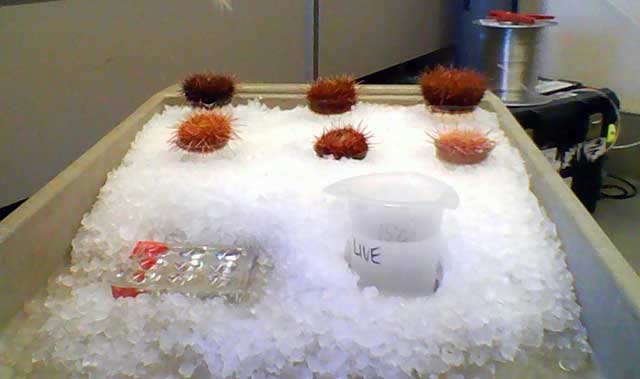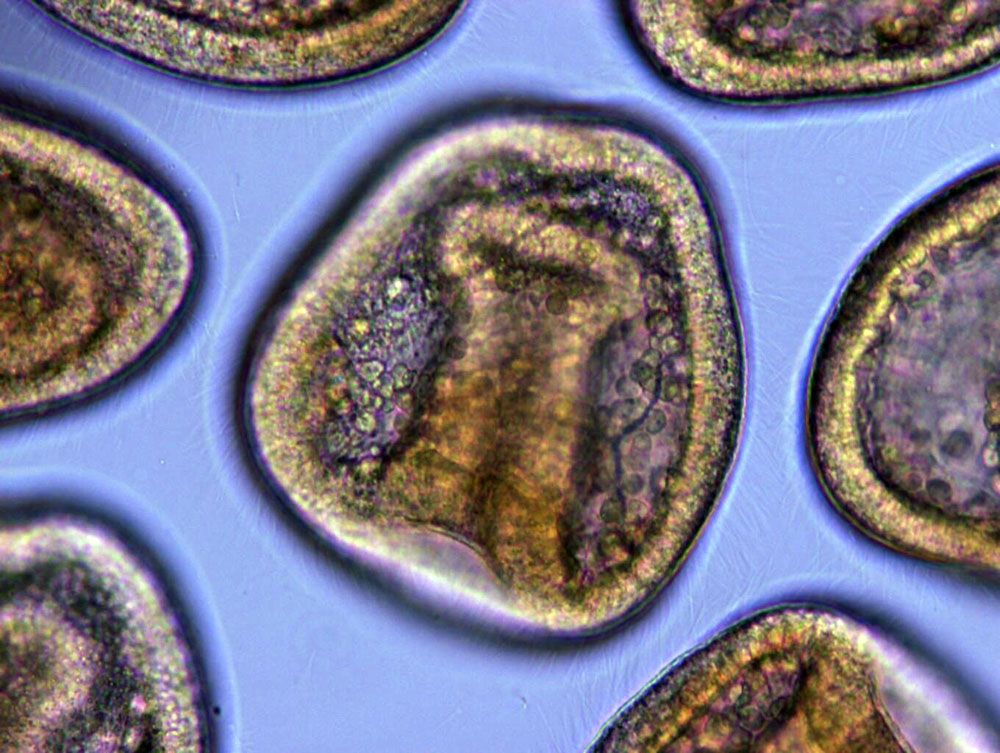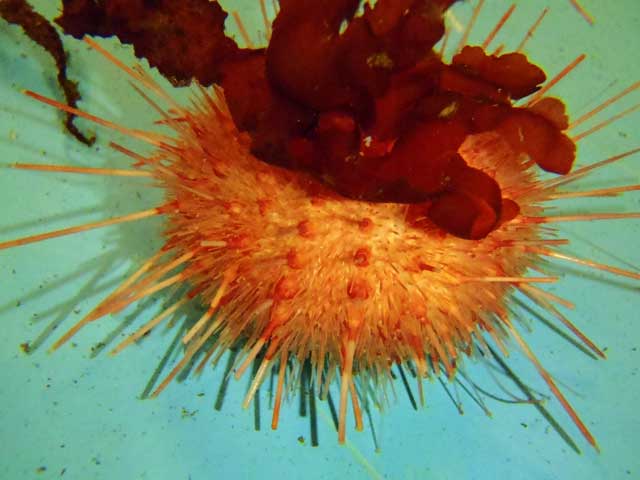|
Thorny problemSea urchin larvae show reduction in size from ocean acidification experimentsPosted January 17, 2014
Scientists already know that shell-building marine organisms face an uncertain future in a world where increased levels of atmospheric carbon dioxide have turned seawater more acidic. But the consequences of what some have dubbed “the other CO2 problem” are only now being studied and understood at the most fundamental levels of biology. One prolific little species in the Antarctic, where subfreezing water temperatures help gases like carbon dioxide more readily dissolve, may help researchers understand how some organisms might respond to ocean acidification down to the cellular level. The sea urchin Sterechinus neumayeri covers the seafloor in what appears to be a never-ending carpet of purplish pincushions. Its circumpolar distribution and influence on the food web make it a keystone species – and one of the most well-studied marine animals in the Antarctic. 
Photo Credit: Amanda Kelley
Adult sea urchins chill out in a bath tub of ice in the Crary Lab aquarium. The animals live at about minus 1.8 degrees Celsius.
“They have the capacity to alter ecosystem function,” noted Amanda Kelley “Urchins are primarily herbivores, so small changes in the abundance and distribution of this organism can drastically alter the surrounding biodiversity.,” added Kelley, a member of Gretchen Hofmann’s lab Ocean acidification is a direct result of increasingly higher levels of carbon dioxide in the atmosphere. Sea urchins and many other marine invertebrates, from corals to clams, use the calcium carbonate minerals of calcite or aragonite to construct their shell coverings or skeletons. This requires supersaturating concentrations of the carbonate ion in seawater. Normally that’s not a problem. However, it turns out that oceans serve as a great sink for CO2, absorbing up to a third of it from the atmosphere. But it comes at a cost by altering the seawater chemistry and turning it more acidic. As ocean pH falls, so does the concentration of the carbonate ion. An ecological physiologist, Kelley is interested in learning how environmental stresses like ocean acidification affect S. neumayeri and other marine organisms. But it’s not the only threat. Ocean temperatures are also expected to rise. And as Antarctica’s massive ice sheets melt, the additional freshwater will affect the salinity, or saltiness, of the ocean. 
Photo Courtesy: Anne Todgham
Amanda Kelley, center, is studying ocean acidification effects on sea urchin larvae in Antarctica. Her colleagues in the photo are working on a separate project to understand how the early stages of fish life may be affected by acidifying seawater.
“Reduction in salinity is yet another factor associated with climate change,” Kelley said. “The ocean world is obviously very dynamic. We need to do a better job of simulating what those environmental conditions are.” Kelley’s two-year field project involves collecting sea urchin larvae for experiments that look at everything from their organismal development to cellular responses by subjecting them to varying levels of pH based on future projections of atmospheric CO2. One future scenario involves sending seawater saturated at about 700 microatmospheres (µatm) of carbon dioxide into white buckets that contain purple sea urchin larvae that are just days old. “The scenario that I’m trying to replicate is not the most extreme that the Intergovernmental Panel on Climate Change A previous experiment by former NSF postdoc Pauline Yu, who also worked in Hofmann’s lab, found larvae 21 to 31 days old were about 10 percent smaller than normal when exposed to more acidic seawater than today. Kelley looked back even earlier, as young as six days after fertilization, and also saw a difference in body size. Stunted growth can affect the sea urchin larvae’s foraging ability and mobility. In adults, body size correlates to fecundity and survival, according to Kelley. “There are a lot of ecological implications in terms of the organism interacting with other organisms and the organism interacting with its environment,” she said. An obvious question emerges: What is the connection between lower ocean pH and body size? Kelley is looking at biomedical studies for one possible hypothesis – in particular, cancer research. Cancer involves the uncontrolled proliferation of cells. One strategy that scientists have used to arrest the development of cancer cells is to induce intracellular acidosis – increasing cellular acidity. Are sea urchins experiencing intracellular acidosis? Measuring intracellular pH during the sea urchin’s early development period may offer some clues. “We don’t know how these organisms regulate their intracellular pH living in an acidic environment,” Kelley said. “We’ve done a million other things – huge, broad gene array studies looking at broad-scale transcription.” Next season, Kelley will return to conduct additional experiments in McMurdo’s aquarium space, located on the bottom level of the Albert P. Crary Science and Engineering Center Earlier results from Hofmann’s experiments suggested the spiky marine critters are hardier than originally thought. However, that doesn’t appear to be the case for all organisms. Scientists have documented oyster larvae in the Pacific Northwest that were literally blasted by colder, more acidic waters welling up from the depths of the Pacific Ocean that caused widespread mortality. “We had no idea these upwelling events were so acidic and they could have such a big impact on marine life until somebody’s pocketbook got dinged,” Kelley said. “The global scientific community is really galvanized in understanding ocean acidification. It’s is a real threat to ocean ecosystems.” NSF-funded research in this article: Amanda Kelley, University of California, Santa Barbara, Award No. 1204181 |



For USAP Participants |
For The Public |
For Researchers and EducatorsContact UsU.S. National Science FoundationOffice of Polar Programs Geosciences Directorate 2415 Eisenhower Avenue, Suite W7100 Alexandria, VA 22314 Sign up for the NSF Office of Polar Programs newsletter and events. Feedback Form |



